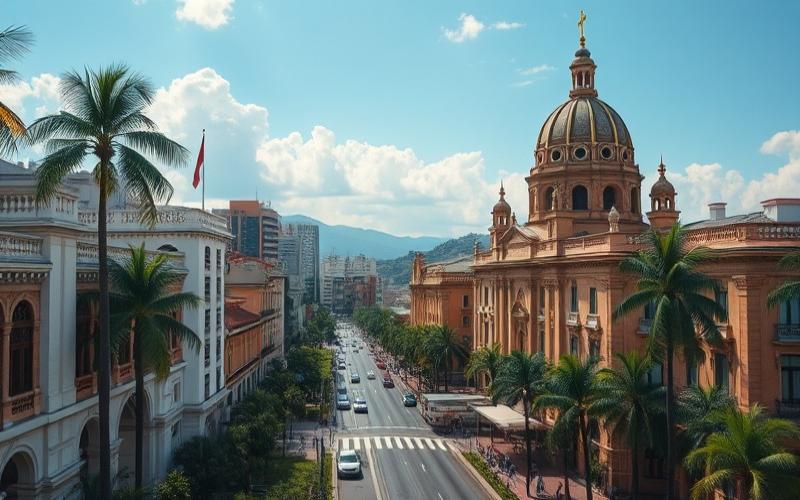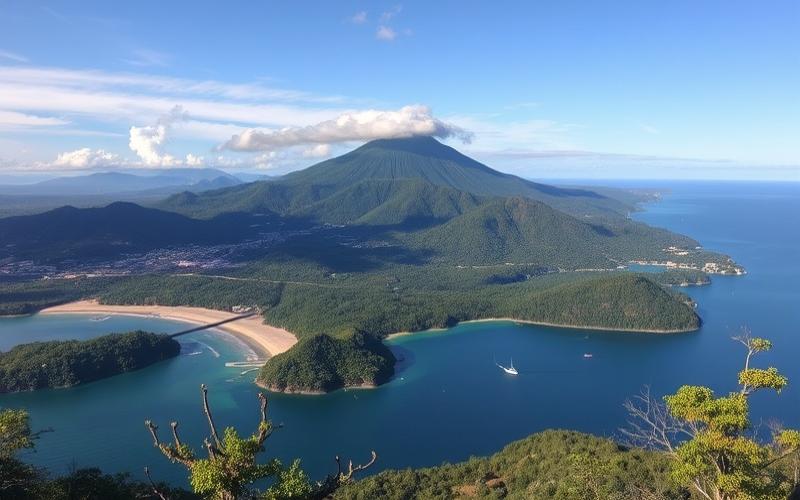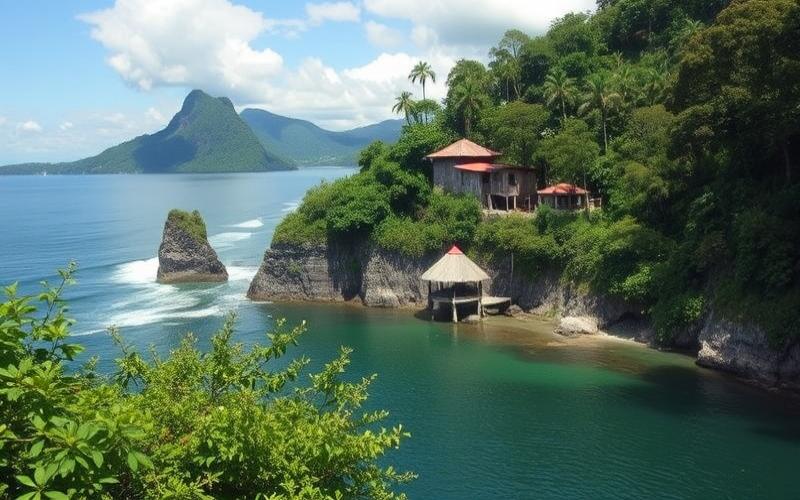
 Published on and written by Cyril Jarnias
Published on and written by Cyril Jarnias
Costa Rica: Digital Nomad Paradise
Costa Rica, known for its biodiversity and stunning landscapes, has become a true magnet for digital nomads, these modern workers who trade the office for a virtual office in the tropics.
A Marked Impact on the Rental Market
The arrival of these professionals seeking flexibility and quality of life has led to a significant disruption of the local rental market, stimulating the economy but also raising challenges in terms of housing availability and prices for the local population.
Good to Know:
Costa Rica has implemented a specific visa for digital nomads, valid for up to 2 years, to attract this population while regulating its impact.
Finding Balance Between Opportunities and Challenges
While Costa Rica positions itself as a destination of choice for this new wave of workers, the socioeconomic impact of this phenomenon deserves particular attention, both for the opportunities it creates and the tensions it exacerbates.
The Rise of Digital Nomads in Costa Rica
Costa Rica stands out as a preferred destination for digital nomads thanks to the combination of several major assets: a pleasant climate year-round, exceptional biodiversity, a welcoming local culture, and reliable digital infrastructure. These elements have contributed to attracting a growing number of remote workers, particularly in coastal or urban areas.
Attractiveness Factors for Digital Nomads in Costa Rica:
- Temperate tropical climate, ideal throughout the year.
- Remarkable biodiversity with accessible national parks, beaches, and forests.
- Culture renowned for its friendliness (“pura vida”) and openness to foreigners.
- High internet penetration rate (92.6% in 2025), widespread access to fiber optics in major cities and tourist hubs.
- Dynamic international communities (coworking spaces, dedicated events).
| Factor | Description | Impact on Digital Nomads |
|---|---|---|
| Climate | Stable tropical | Outdoor living facilitated |
| Biodiversity | Beaches, jungles, varied wildlife | Nature activities after work |
| Culture | “Pura vida”, hospitality | Easy social integration |
| Internet | 92.6% access rate; moderate speed | Smooth work |
Specific Government Initiatives:
- Launch of the special “Digital Nomad” visa since 2022:
- Initial duration of 1 year (renewable)
- Possibility of entirely online application
- Tax exemption on foreign income
- Right to family reunification
- Moderate visa cost compared to other similar destinations
Summary of Incentive Measures:
- Accessible digital visa without complex conditions
- No local taxation on income earned outside Costa Rica
- Simplified procedure to extend stay
Recent Data & Regional Trends:
Approximately 50% increase in the number of recorded digital nomads between 2023 and mid-2025. The country now ranks in the global top 10 of stated preferences among this mobile population.
The particularly sought-after areas are:
- San José: Economic heart with modern infrastructure and numerous coworking spaces.
- Pacific Coast (e.g., Tamarindo): Rapid growth (+19% in check-ins over five years), surfing and beach life attract the international community.
- Caribbean Region: More niche but favored by those seeking cultural authenticity or preserved environment.
| Region | Main Assets |
|---|---|
| San José | Urban connectivity, coworking spaces |
| Pacific Coast | Relaxed atmosphere, beaches/digital cafes |
| Caribbean | Wild nature, Afro-Caribbean culture |
Local Sociocultural Implications:
The massive arrival of digital nomads is gradually transforming certain communities:
- Rise in real estate costs in some popular beach towns.
- Significant increase in the overall level of spoken English locally.
- Creation of new economic opportunities (specialized coworking cafes…).
Perceived Risks:
- Mixed feelings among some residents regarding real estate inflation or the rapid evolution of the traditional community fabric.
- Occasional tensions around the coexistence between globally connected temporary visitors and local populations attached to historical customs (“gentrification”).
Costa Rica thus remains an emblematic example where digital tourism rhymes as much with opportunities as with local social challenges.
Good to Know:
Costa Rica has become a preferred destination for digital nomads thanks to its pleasant climate, exceptional biodiversity, and welcoming culture, reinforced by reliable digital infrastructure. The government has implemented initiatives like special visas to attract these remote workers, contributing to a significant influx of digital nomads, with recent estimates suggesting a notable concentration in regions like San José and along the Pacific Coast. This influx influences the local rental market, bringing economic dynamism but also raising concerns about the rising cost of living for locals and the preservation of local culture. Reactions are mixed among residents, who recognize both the economic benefits and cultural challenges of this new wave of international remote workers.
Coliving and Coworking: A New Trend
Digital nomads in Costa Rica have strongly stimulated demand for coliving and coworking spaces, transforming these models into a major trend in the country’s tourist and coastal regions.
Why These Options Particularly Appeal to Digital Nomads:
- Affordable Cost:
- Coliving spaces provide access to all-inclusive furnished housing, often cheaper than a traditional individual lease.
- Possibility to rent a private or shared room, significantly reducing the housing budget.
- Utilities (high-speed internet, electricity, cleaning) are generally included.
- Contractual Flexibility:
- Weekly or monthly rentals, without long-term commitment.
- Ease to move in quickly with minimal administrative procedures.
- International Community and Networking:
- Environment conducive to professional and personal exchanges among digital nomads from around the world.
- Community activities fostering connection creation (workshops, social events).
- Stimulating Environment:
- Spaces designed for productivity (coworking with fast internet, ergonomic desks).
- Privileged natural setting – beaches renowned for surfing, tropical jungles – promoting work-life balance.
Impact on the Local Rental Market
| Advantages | Challenges/Risks |
|---|---|
| Local economic stimulation | Potential rent increases in some highly sought-after areas |
| Extension of tourist seasons | Increased pressure on traditional rental supply |
| Creation of direct/indirect jobs | Risk of exclusion for low-income local residents |
In beach towns like Uvita or Sámara, the growing influx of nomadic workers has contributed to increased real estate profitability. However, this can also lead to a gradual rise in rental prices for permanent residents.
Recent Statistics on Sector Growth
- The number of dedicated coworking/coliving spaces has increased annually for five years in coastal areas like Tamarindo, Santa Teresa, and Uvita.
- For example:
- In Uvita (2025), Mango Coliving offers several fully equipped apartments and rooms with direct access to a modern coworking space specifically designed to meet the needs of digital nomads.
- In Sámara (2025), Locoworking combines inspiring shared spaces and community accommodation attracting both international and local freelancers.
Popular Examples Among Digital Nomads
Non-exhaustive list:
- Mango Coliving Uvita
- Guaranteed high-speed internet with UPS system
- Pool & tropical gardens
- Dynamic community
- Locoworking Sámara
- First space combining coliving/coworking in this coastal town
- Strong orientation towards sharing creative ideas
✨ The accelerated development of coliving/coworking in Costa Rica thus rests on three major pillars: reduction of overall cost; total flexibility; international community dynamism. While this trend stimulates the local economy by diversifying the tourist offer outside the classic season, it nevertheless requires careful regulation so that its effects benefit both newcomers and local populations equitably.
Good to Know:
In Costa Rica, the rise of digital nomads has led to strong demand for coliving and coworking spaces, due to their appeal for increased flexibility, lower costs compared to traditional rentals, and a genuine creative and professional community. Coliving spaces, like Outsite in Santa Teresa, offer all-inclusive solutions combining accommodation and work, while coworking spaces such as Selina or Impact Hub in San José provide modern infrastructure. The rapid growth of these places is illustrated by a 25% increase in coworking and coliving spaces in 2023 compared to the previous year. However, this popularity puts upward pressure on local rents, especially in highly sought-after areas like Tamarindo and Nosara, posing challenges for residents already struggling to find affordable housing.
The Impact on the Local Rental Market
Increased Demand for Housing in Popular Areas
Cities like San José, Playa del Coco, and Puerto Viejo de Talamanca are experiencing a strong increase in rental demand linked to the growing arrival of digital nomads. This phenomenon is explained by:
- The appeal of a flexible lifestyle, with access to digital and community services.
- The search for spaces adapted to remote work (fast Wi-Fi, quiet spaces, proximity to cafes or coworking spaces).
- Increased seasonality: some neighborhoods see their population rise sharply during tourist periods.
Concrete example: Many accommodations explicitly advertise their adaptation to the needs of digital nomads (“Digital Nomad House & Workspace”, “Studio Ideal for Remote Workers”).
Impact on Rents
The massive arrival of foreign remote workers has contributed to:
- A significant increase in rental prices in these sought-after areas.
- Increased competition for available properties, especially in the furnished or short/mid-term rental market.
| Area | Average Rent Evolution (2022–2024) | Type of Impact |
|---|---|---|
| San José | +15 % | Increase |
| Playa del Coco | +20 % | Increase |
| Puerto Viejo | +18 % | Increase |
These increases are accentuated by the superior financial capacity of some digital nomads compared to local residents.
Opportunities for Local Property Owners
The growing presence of digital nomads offers several advantages:
- Potential increase in rental income, thanks to an international clientele willing to pay more for adapted housing.
- Incentive to renovate or modernize their real estate properties (Wi-Fi improvement, ergonomic furniture).
- Possibility to optimize occupancy rates through short-term rentals.
Observed examples:
- Transformation of traditional apartments into fully equipped studios dedicated to remote work.
- Investment in outdoor amenities (pool, common areas).
Tensions and Inequalities in the Local Market
The massive influx of newcomers can generate several tensions:
- Decrease in the number of available housing units for traditional tenants (local families or permanent workers).
- Gradual loss of access to affordable housing for a significant portion of the local population.
Main effects felt:
- Forced geographical displacement to less expensive peripheries
- Growing feeling of social injustice among some residents
Central Role of Digital Platforms like Airbnb
Platforms such as Airbnb, but also Booking.com and Vrbo play a determining role:
- They facilitate connections between property owners and international digital nomads.
- Many accommodations explicitly mention their adaptation to specific needs (“high speed internet”, “workspace”, “remote worker friendly”).
Summary table – Recent Airbnb examples targeting this clientele:
| Location | Highlighted Features |
|---|---|
| La Fortuna | Integrated coworking space |
| Escazú | Studio equipped with high-speed Wi-Fi |
| Tamarindo | Proximity to pool & office space |
This sometimes favors a massive conversion of the traditional rental stock towards these more profitable offers.
Initiatives/Local Regulations Aiming for Market Balance
Faced with observed imbalances, some municipalities are implementing various initiatives:
- Temporary or annual limitation on the maximum number of rentable days via Airbnb
- Declarative obligation to municipal authorities
- Tax incentives or aid intended for owners renting primarily long-term
Some testimonies, however, indicate that these measures remain partially applied depending on the area concerned.
In summary, while the massive arrival of digital nomads undeniably creates new economic opportunities, it also generates persistent social tensions around affordable housing. Authorities are currently seeking a balance between international attractiveness and preservation of the local fabric.
Good to Know:
In attractive areas like San José, Playa del Coco, and Puerto Viejo de Talamanca, the growing presence of digital nomads has led to a notable increase in housing demand, thus pushing rents upward due to high competition for often limited housing. Local property owners benefit from this situation through increased rental income and the incentive to modernize their properties to meet the expectations of digital nomads, often high with specific standards. However, this creates tensions in the rental market, making housing less affordable for traditional residents who face pressure on housing availability. Digital platforms like Airbnb facilitate access to these accommodations tailored to digital nomads, sometimes to the detriment of local actors. Some municipalities have implemented regulations to try to moderate the impact, such as rent caps or regulation of short-term rentals, to preserve the balance of the local market.
Disclaimer: The information provided on this website is for informational purposes only and does not constitute financial, legal, or professional advice. We encourage you to consult qualified experts before making any investment, real estate, or expatriation decisions. Although we strive to maintain up-to-date and accurate information, we do not guarantee the completeness, accuracy, or timeliness of the proposed content. As investment and expatriation involve risks, we disclaim any liability for potential losses or damages arising from the use of this site. Your use of this site confirms your acceptance of these terms and your understanding of the associated risks.















































